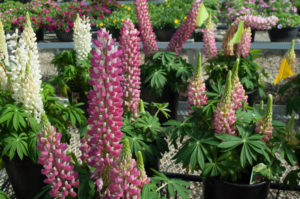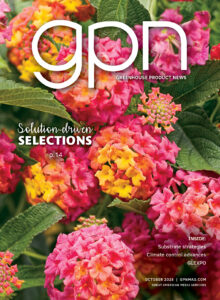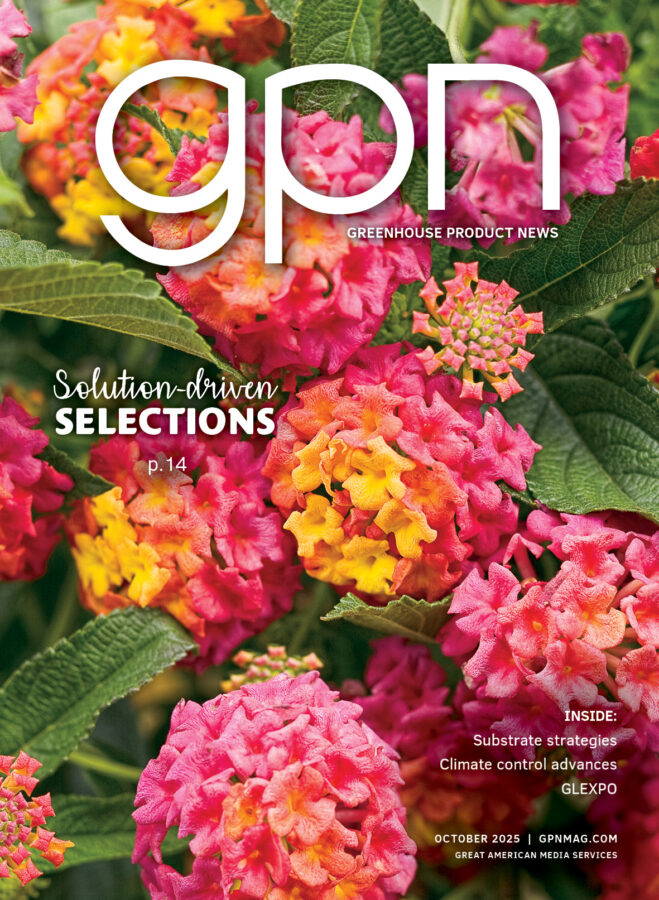
Culture Report: Lupine Staircase Series
A long standard in gardens and retail garden centers, the showy blooms of lupine have consistently been a fantastic retail impulse purchase. Their main drawback has been the short bloom window. Over several years of breeding, Green Fuse Botanicals is now able to provide a grower solution for this age-long issue.
BACKGROUND INFORMATION
Lupine has forever been a summer or fall planting for spring sales. Going through the winter for the required vernalization often leads to a percentage of the crop being lost to freeze, moisture management issues or anthracnose. The Staircase series is the first of its kind in the Lupinus genus.

Staircase lupine are daylength neutral and require zero cool treatments. They also reinitiate their impressive flower spikes throughout the season — removing the stigma of “one and done.” This breakthrough allows growers to, for the first time ever, schedule a lupine crop through the season. No longer is holding the crop to meet a ship date required, we may now schedule for the required ship date.
The Staircase series, hardy to Zone 4, consists of three eye-catching solid colors of Red, Yellow and White and the three Dupline (dual color lupine) of Blue/White, Rose/White and Orange/White. Their well-rounded habit lends themselves well to one plant per pot in 8-inch container production. These liners produced via tissue culture from Gulley Greenhouse may be directly transplanted into the finished container.
FINISHING
Temperature. It may prove beneficial to equate the finishing of the Staircase series with that of a pelargonium or carnation. Maintaining cost-effective cool temperatures will produce a well hardened finished package. Day temperatures of 60 to 65° F and night temperatures of 57 to 62° F produce very active vegetative growth for a uniform finish.
Media. Use a well-drained soil mix, preferably with bark and a pH range of 5.8 to 6.4. Water well and allow soil to dry between irrigation. Avoid over watering, especially during cool and cloudy weather. Maintain EC at 0.08 to 1.25 in a peat/bark mix. Anthracnose may be inherent within seed produced Lupine, so it is highly recommended to keep the Staircase series in a different production zone to avoid contamination from water droplets.
Fertilization. Feed at 75-ppm nitrogen every irrigation or 150- to 200-ppm nitrogen with alternate clear water irrigation. Lupine are sensitive to high salt levels. Growers using controlled-release fertilizers get the best results by incorporating at a rate equivalent to 1.0 to 1.25 pounds of nitrogen per yard of growing medium.
PGRs and pinching. When the liner has rooted well through the container, approximately week five, it is beneficial to apply Configure at a rate of 150- to 175-ppm to promote lateral branching. The dominant terminal shoot will develop week eight or nine. The first flower is the largest (18 to 24 inches) and may be left if you are a retail grower. For wholesale growers, it is advised to pinch this terminal to promote lateral shoot development. The shoots developed after the pinch will number from three to five and will be much more stout at 10 to 15 inches, allowing for more units per shelf.
Plant growth regulators may be used when required for hardening of the foliage. A tank mix of 2,500-ppm B-Nine and 3-ppm Sumagic have provided the most consistent results. Maintaining these temperatures will have a retail ready container in eight to 12 weeks.
Scheduling. Scheduling the Staircase series with multiple ship dates of the liners will minimize plant maintenance for the grower and provide fresh product for retail. It is best to avoid the height of summer heat for production as this will cause flower delay. Since the Staircase series, unlike all other lupine on the market, does not require minimum hours of daylength for flower initiation, it is a programmable process to be first to the market with the impressive flower spikes.
Green Fuse Botanicals has been able to supply a consistent, near year-round availability so regardless of your geographic location, it’s Staircase time!









 Video Library
Video Library 


















